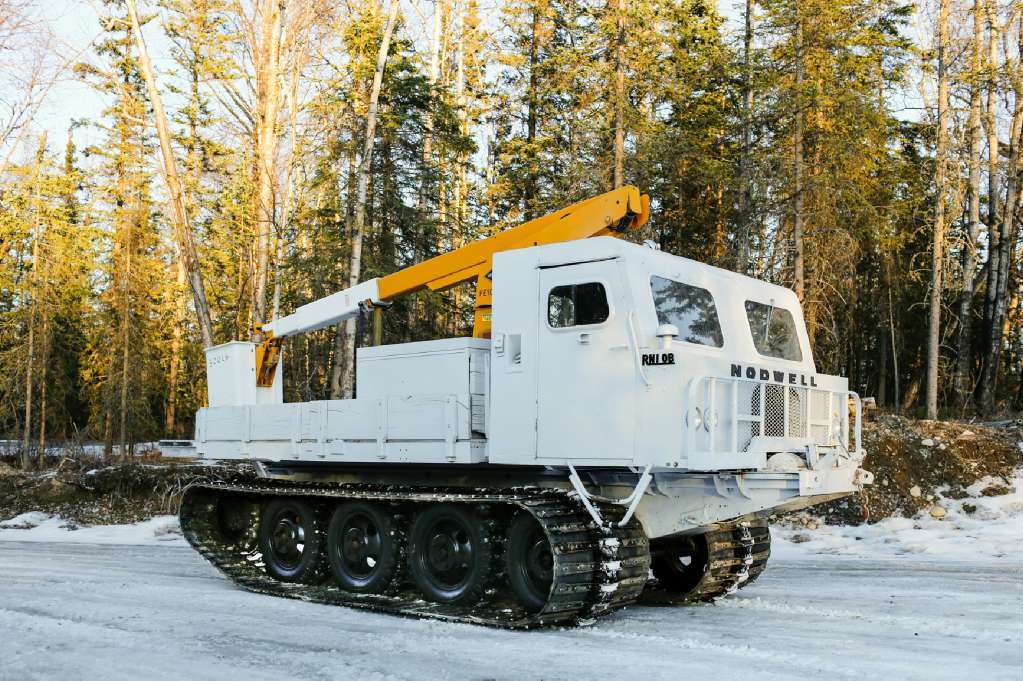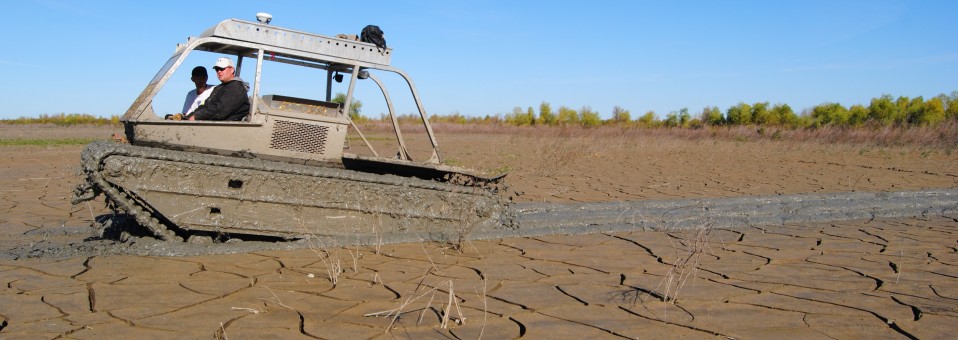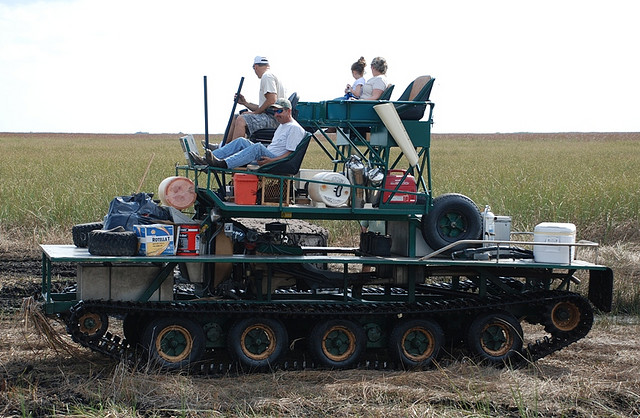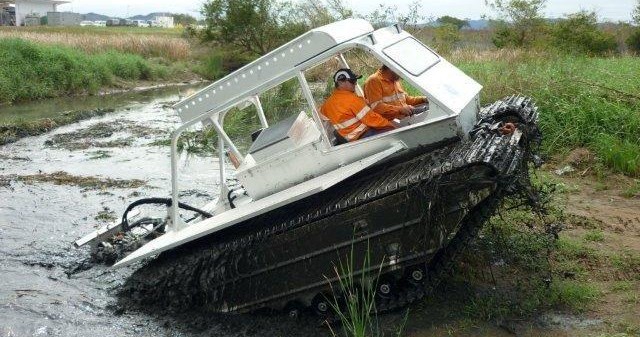My first Nodwell was exactly like this white one. It was a former military unit originally powered by a Ford 292 V8 and Clark 5-spd. One way to tell the early versions is to look at the number wheel lugs (this one has five). Five proved to be to weak due to the pressure on the studs when turning side ways. They then went to six lug hub that was better, but still weak. They've used ten lug hubs now for about 30+ years.
You can also tell the earlier rigs by a quick glance at the front axle. As in the picture of the white rig, the track wraps around the front tire which slides back and forth to provide track tension from two small hydraulic cylinders between the frame and tires on each side. The cylinders are pressurized by a grease gun.
In the picture of the white Nodwell, on the left front fender it has "RN1 0B" in black letters. There is actually a numeral missing - it should read "RN110B". RN110 is the model and the B version was the military version.
The military versions had the 292 V8 engines in them versus the straight 6 Fords in the original / civilian versions. I think the military wanted more power because they hauled tracked trailers made form the same chassis behind. And interestingly, they used air brakes to brake the trailer. Mine still had the air glad hands on the rear but the air compressor was gone. It also had a 12V generator on it instead of an alternator. The T-Bird people at Hot August Nights showed me how to easily change that out.
And note, the recessed indent behind the front door, between the door and the door latch, is the filler for the fuel tank. On these, due to lack of room probably, the seats were the fuel tanks. Each tank was 50 gallons for a total load of 100 gallons - they didn't get good fuel mileage. The tank seats were surprisingly comfortable for steel tanks. They curved the seat portion for your rear and back to make them more comfortable.
As said, they moved to 6 lug wheels and then 10 lug wheels when they also added a front idler axle to the rig. The idler axle did two things, it added more track which increased the surface area and therefore reduces the track ground pressure in the mud. The idler hubs also rotated forward to allow a lot easier tension adjustments to the track.
The weight of this rig, without the gear on the back or a load is about 18,000#. The RN60 version I'm looking to repower is about 10,000# with a gas engine or 10,500# with a 453 Gimmy and Allison.
A lot of 60s came with Ford straight six engines. They do fine, but I think they might actually use more fuel than the 391s because you have your foot in them more working the engine harder.
You can put too much power into these rigs. When Western Geophysical used a lot of RN110s and RN160s on the North Slope, they took out the straight 6s and repowered them with 453 or 653 diesels. The 453s in the 110s and the 653s in the 160s were about right. Besides the rig weight the 110 was rated to haul 14,000# and the 160 was rated for about 16 - 18,000#s of cargo. The problem was they used what engines they could get so sometimes the 653 engines wound up in a 110 which was too much power for the rear ends in them with a lot of cargo. When they got into a bad situation they could tear out a rear end. The rear ends in a 110 are very complicated and include the brake bands used to steer it. A "pumpkin" for a 110 is very complicated and costs about $20K. I'd like to repower one of these someday with a diesel and auto from one of today's diesel pick up trucks.
As grumpyvette suggested, it appears from my looking the last couple of days, the cheapest thing to do is buy an old truck to take engine, transmission and possibly a gear reduction box out of. It certainly looks cheaper than buying the individual parts and trying to see make everything matches. Plus with the old truck, you get the cross members and mounts.
I wouldn't need an overdrive transmission though. With a Clark five speed, I've only used 5th gear a couple of times. In the terrain we're in, it's never good enough for that speed (maybe 7 - 9 mph though my GPS did say I hit 10mph for a couple hundred feet one time). At anything above about 6 mph, you get shook around too bad and you increase your chances of slipping a track. Been there, done that a couple of times. So any increase in mileage has to be with a better engine.
You can down shift in the mud, but you can't upshift. Think about upshifting for a moment. In a car or truck, you take the rpms or speed up to a certain point, put in the clutch, the vehicle rolls along as you change gears. Depending on load or uphill grade, you may loose a little bit of speed, but have no problem in moving to the next gear. In these things, the speed difference between gears is from .5 to 2 mph max. If you slow down a little bit, then you've lost your speed or power curve to shift in. When you're in a lot of mud, pushing it, when you put in the clutch to shift, the mud starts slowing you down immediately.
To give you an extreme idea of how much mud we're in with these things, look at the bottom of the doors, they're at least 4' off of the ground. I've had mud coming in the doors lots of times. You normally travel with the door open because the engine is n the cab and is hot. Even traveling in good mud, maybe only a food deep, it still really drags on the rig when trying to upshift.
Look above the RN1 0B black letters and you'll see the air intake. On the way to where we hunt, there's a lake with a stream that feeds into it that you have to cross. It's a huge mud hole about a hundred yards across and varies in depth from the top of the tracks to coming in the doors. One year I decided to take a new way across it. Well, I happened to hit one of the old channels of the creek under the mud that I couldn't see. The right side of the rig dropped down so far, it sucked water in that air intake and drowned the engine. It took two other rigs, both larger than mine, to yank me out of there. I must say that I had it running again in about 45 minutes.
Now, I think I'll look for a truck to take everything out of. I'll have to look for different shift linkage - the problem is I don't know what it's called??? Most of the transmissions are Clark 5 spds. The "gear shift" is a short stub coming out of the top of the transmission that's about 3" high. Then the linkage goes to the left side of the transmission usually under the floor boards, then makes a right 90 going toward the front of the rig, then it comes up through the floor board, or sometimes out of the engine cowling besides the drivers right leg. Looks like I'll be off to visit the truck junk yards.
Thanks,
Bill




